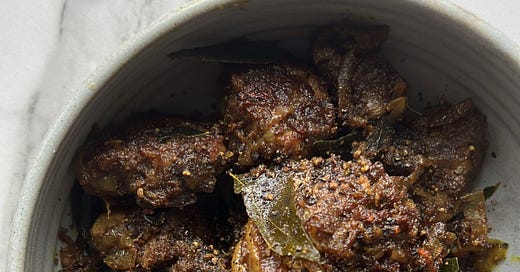Curry leaves, or kari patta, are the ultimate in fragrant flourishes, a must have for cooking the food of South India and some recipes from the West of India. While often confusingly refered to as a spice, it is, in fact, a herb and best used freshly picked off the plant.
The curry plant is a tropical shrub that thrives in hot and arid climates. In fact, I was amazed to see trees thriving in parched soil in the backwaters of Kerala. In colder climes, you can grow your own on a sunny windowsill, moving it outdoors and keeping it watered in summer. While the plant enjoys a good drenching, it doesn’t like being waterlogged. I killed mine in a pandemic house move, if I am completely honest.
In the absence of a handy curry leaf tree, you can buy bagged fresh curry leaves online and in South Asian grocery stores. They last for months in the freezer, so grab a stash to store for later. I tend to shove the branches and leaves in airtight containers straight from the packs. Curry leaves are usually sizzled in hot oil to extract their heady, aromatic best and my freezer preserves them first, rendering them rather germ free in my humble opinion, so I don’t bother washing or drying them first. Although, for those of you more squeamish than me, I could watch this video and method from Sanjana Modha on repeat.
Finally, we must talk about dry curry leaves. I affectionately describe these as mildly scented parchment paper. They are better than nothing at all, but not a patch on the real thing. I would avoid it completely if possible. If it isn’t, go big and double the stated quantity. You could also crisp them in a bit of neutral oil and blend them with sea salt to use as a seasoning to max out whatever minute flavour potential they possess.
Kerala Duck Roast recipe
Black pepper, curry leaves, crispy sweet shallots bring holiday vibes to life in this Duck Roast recipe from the Syrian Christian community of Kerala. The word roast here implies “cooking in its own juices” or without the addition of liquid. I made a note of this on a research trip to Kumarakom, in the backwaters of Kerala, in full view of flapping ducks which was interesting to say the least.
There are recipes for whole duck roasts too, although I am yet to avail of one. This is a quick fix - I bring oven roasted duck breasts to their finale in the sizzling spices. Importantly, the onions need to be caramelised to contribute fully to the dark and rich end result.
Feeds 2:
2 duck breasts, skin on
4 tbsp organic unrefined coconut oil
10-15 fresh curry leaves
2 large shallots, sliced
4 garlic cloves, grated
1 inch ginger, grated
1 tsp turmeric powder
1 tsp chilli powder
1 tbsp coriander powder
Half tsp garam masala
1 tsp coarsely ground black pepper
Salt to taste
Preheat the oven to 180C (160C for fan assisted) and roast the duck breasts for 15 minutes. Remove from the oven and leave to rest.
In a wok or kadai, bring the oil to medium high heat. When it’s hot, toss in the curry leaves, the shallots, and sauté for five minutes until they take colour. Now add the garlic and ginger and and stir for another five minutes until golden.
Add the turmeric, chilli and coriander, stirring through for a minute. If the spices need help getting unstuck, you can add a dash more coconut oil. No water allowed!
Then, thickly slice the duck breasts and stir them through the spice in with their skin on. Pour in any juices that have settled too. When the duck is evenly drenched in the spices mix in the garam masala, ground black pepper and salt.
This is excellent with Kerala Parotta, of course, but Shana’s plain frozen parathas are a quality stand in.






Reading this just makes my mouth water will definitely be cooking this at the weekend, what are Shana parattas? is that a brand or another recipe
I am tempted to try this with a whole duck for a Sunday lunch!